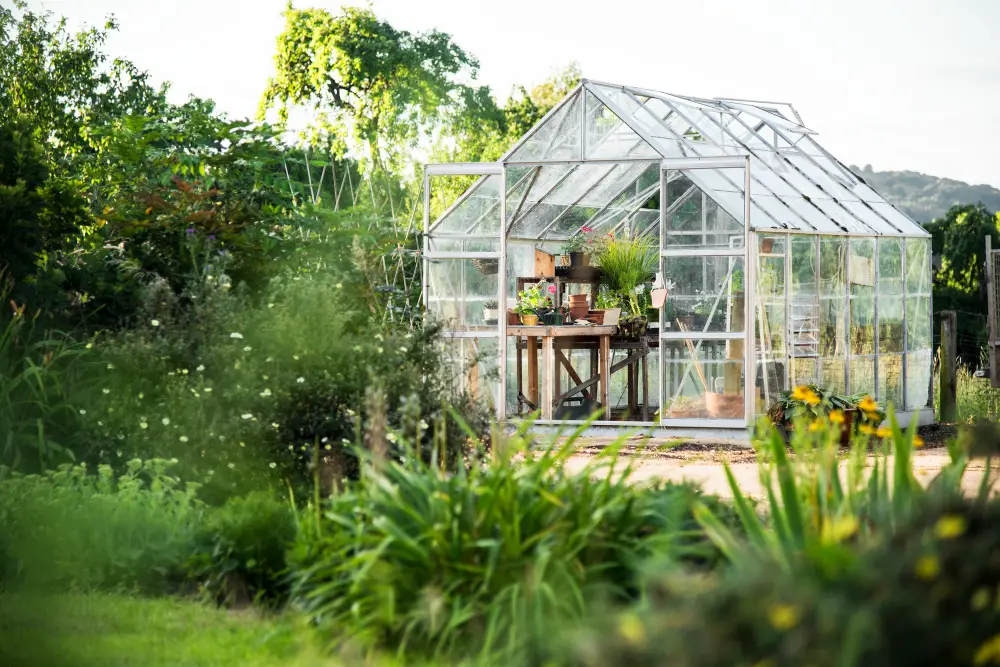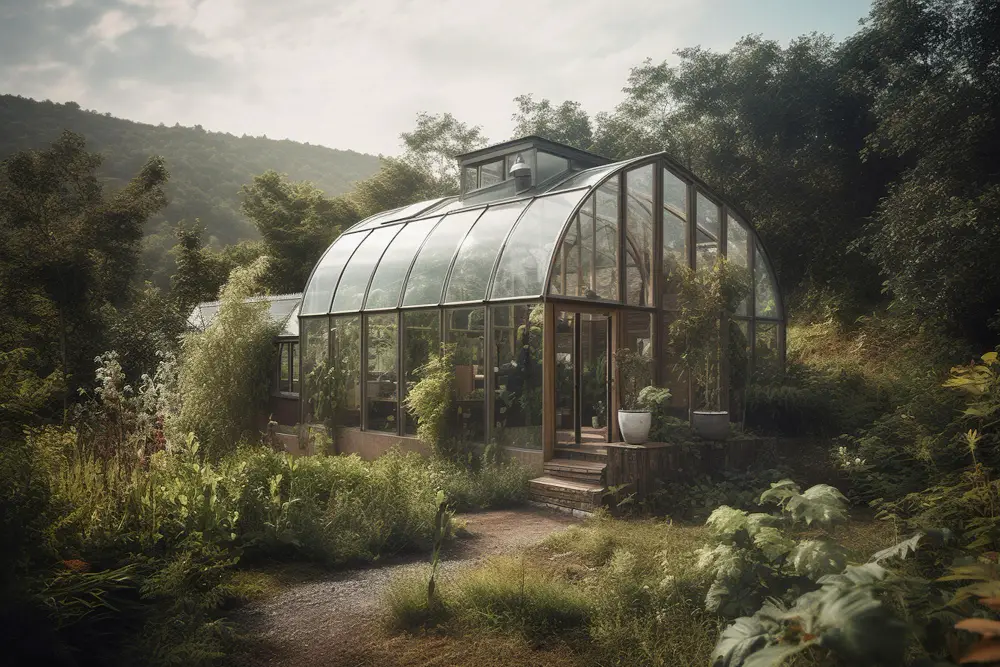Last updated on
Greenhouses play a pivotal role in modern agriculture, allowing for controlled environments that optimize plant growth and yield. Enhancing the design and functionality of greenhouses is crucial for promoting sustainability, resource efficiency, and improved crop management.
In this blog, we explore eight practical approaches that can elevate greenhouse functionality, from efficient space utilization to sustainable materials, climate control, energy-efficient lighting, water management, integrated pest management, technology integration, and considerations for accessibility and ergonomics.
What's Inside
Sustainable Materials and Construction

A. Eco-friendly Building Materials
Choosing eco-friendly building materials is a fundamental step toward sustainable greenhouse design. Opting for polycarbonate panels for greenhouses or materials with low environmental impact, such as recycled or reclaimed materials, contributes to a greener construction process.
Polycarbonate panels offer several environmental benefits, including high durability, energy efficiency, and the ability to diffuse sunlight effectively. These panels are lightweight, reducing the overall material and transportation footprint. Additionally, their insulation properties contribute to energy conservation by minimizing the need for artificial heating or cooling.
Choosing eco-friendly materials aligns with a commitment to reducing environmental impact, making polycarbonate panels an excellent choice for constructing greenhouses that prioritize both functionality and sustainability.
B. Passive Solar Design
Passive solar design is a fundamental strategy for enhancing the sustainability of greenhouse structures. By harnessing natural sunlight to heat the interior spaces, passive solar design reduces the reliance on artificial heating systems, contributing to energy efficiency.
The orientation of the greenhouse, placement of glazing, utilization of solar panels, and incorporation of thermal mass elements work in tandem to capture and store solar heat effectively. This eco-friendly approach not only promotes a more stable and comfortable climate for plant growth but also aligns with the broader goal of minimizing the environmental impact of greenhouse operations.
Passive solar design is a cornerstone in creating greenhouses that optimize resource use and prioritize energy conservation.
C. Rainwater Harvesting Systems
Rainwater harvesting systems are integral components of sustainable greenhouse design, offering a practical solution to water conservation. By collecting and storing rainwater, growers can reduce their dependence on traditional water sources for irrigation.
This eco-friendly practice conserves water resources and minimizes the environmental impact associated with conventional water supply systems. Rainwater harvesting systems typically involve the installation of gutters, downspouts, and storage tanks to capture and store rainwater runoff from the greenhouse roof.
This harvested rainwater can then be efficiently utilized for irrigation, promoting a closed-loop system that aligns with environmentally conscious greenhouse management. Implementing rainwater harvesting systems exemplifies a commitment to sustainability and resource efficiency in greenhouse operations.
Efficient Use of Space
A. Vertical Farming Techniques
Vertical farming techniques represent an innovative and efficient approach to optimizing space within a greenhouse. By cultivating crops in stacked layers or on vertical surfaces, growers can maximize the use of available space, making vertical farming particularly valuable in environments with limited land area.
This method allows for a higher yield per square foot compared to traditional horizontal layouts. Vertical farming can be implemented using various systems, such as vertical towers, shelves, or hanging structures, providing a versatile solution for different types of crops.
This approach not only enhances space utilization but also facilitates better exposure to light and airflow, contributing to improved plant growth and overall greenhouse productivity. Vertical farming techniques are at the forefront of sustainable greenhouse design, addressing the growing need for resource-efficient and space-conscious agricultural practices.
B. Multi-Tiered Shelving Systems
Multi-tiered shelving systems are a strategic and efficient solution for optimizing space and enhancing functionality within a greenhouse. These systems involve the use of stacked shelves or racks to create multiple planting levels, allowing growers to make the most of both horizontal and vertical space.
Multi-tiered shelving is particularly advantageous for managing different plant varieties, offering a structured layout for organization and accessibility. This design facilitates efficient space utilization and provides a controlled environment for plants at various growth stages.
It allows for easy monitoring, maintenance, and harvesting, contributing to a well-organized and productive greenhouse. Implementing multi-tiered shelving systems aligns with the goal of maximizing available space and creating a versatile environment for diverse crops in greenhouse settings.
C. Utilizing Hanging Planters
Utilizing hanging planters is a creative and space-efficient method to make the most of overhead areas in a greenhouse. Hanging planters offer an innovative way to grow plants vertically, enabling growers to capitalize on unused space.
This approach is particularly beneficial for vining or trailing plants, creating an aesthetic and functional display. Hanging planters can be strategically placed to enhance airflow, access to sunlight, and overall plant health.
By suspending plant containers, growers can achieve a visually appealing and well-organized greenhouse while maximizing planting capacity. This method adds a decorative element and contributes to efficient space utilization and an optimized growing environment.
Climate Control and Ventilation

A. Automated Climate Control Systems
Automated climate control systems enable precise temperature, humidity, and ventilation management within the greenhouse. These systems respond to environmental conditions, ensuring an optimal climate for plant growth and reducing the risk of stress or diseases.
B. Natural Ventilation Strategies
Incorporating natural ventilation strategies, such as roof vents and sidewall openings, promotes airflow and temperature regulation. Strategic placement of openings allows for passive cooling, reducing the need for mechanical ventilation.
C. Shade Structures for Temperature Regulation
Installing shade structures helps regulate temperature by preventing excessive sunlight exposure. Shade cloth or structures can be adjusted to control light intensity, protecting plants from harsh sunlight during peak hours.
Energy-efficient Lighting
A. LED Grow Lights
Utilizing LED grow lights is a sustainable alternative to traditional lighting systems. LED lights are energy-efficient, emit less heat, and can be tailored to specific wavelengths, promoting optimal photosynthesis and plant development.
B. Natural Light Optimization
Maximizing the use of natural sunlight during daylight hours reduces the reliance on artificial lighting. Well-designed greenhouses with ample glazing and proper orientation can capture and distribute sunlight effectively.
C. Smart Lighting Controls
Implementing smart lighting controls allows growers to tailor lighting schedules based on plant needs. Automation systems can adjust light intensity and duration, optimizing energy usage and supporting plant growth cycles.
Water Management and Irrigation
A. Drip Irrigation Systems
Drip irrigation systems deliver water directly to the root zone of plants, minimizing water wastage through evaporation and runoff. This method enhances water efficiency and ensures precise irrigation.
B. Soil Moisture Sensors
Integrating soil moisture sensors provides real-time data on soil moisture levels. This information allows for accurate and timely irrigation, preventing both waterlogging and drought stress in plants.
C. Water Recycling Practices
Implementing water recycling practices involves collecting and treating runoff water for reuse in irrigation. This closed-loop system reduces water consumption and minimizes the environmental impact of greenhouse operations.
Integrated Pest Management
A. Beneficial Insects
Encouraging the presence of beneficial insects, such as ladybugs or predatory mites, helps control pest populations naturally. This eco-friendly approach minimizes the need for chemical pesticides.
B. Companion Planting
Companion planting involves strategically placing plants that repel pests or attract beneficial insects near vulnerable crops. This natural pest management technique enhances biodiversity and reduces the risk of infestations.
C. Non-Toxic Pest Control Measures
Using non-toxic pest control measures, such as neem oil or insecticidal soaps, protects plants without harming the environment. These alternatives offer effective pest management while minimizing chemical impact.
Technology Integration
A. Smart Monitoring Systems
Integrating smart monitoring systems allows growers to remotely monitor environmental conditions. Sensors can track temperature, humidity, and other parameters, providing real-time data for informed decision-making.
B. Automated Plant Feeding Systems
Automated plant feeding systems deliver nutrients to plants in precise quantities. This technology ensures optimal nutrient levels, promoting healthy plant growth while minimizing waste.
C. Data Analytics for Crop Management
Harnessing data analytics tools enables growers to analyze trends and patterns in crop performance. This information informs strategic decisions, enhancing overall crop management and productivity.
Accessibility and Ergonomics
A. Efficient Layout Design
Creating an efficient layout design improves accessibility for growers and reduces the effort required for maintenance tasks. Well-organized spaces contribute to a more ergonomic and productive greenhouse environment.
B. Adjustable Planting Beds
Incorporating adjustable planting beds allows growers to customize the height of growing surfaces. This feature enhances accessibility for planting, pruning, and harvesting, reducing physical strain on workers.
C. Incorporating Sustainable Pathways
Using sustainable materials for pathways within the greenhouse minimizes environmental impact. Eco-friendly pathway materials contribute to a cohesive and environmentally conscious greenhouse design.
The Takeaway
Implementing these eight practical approaches can significantly enhance the design and functionality of greenhouses. By embracing sustainable practices, utilizing space efficiently, incorporating advanced technologies, and prioritizing accessibility, growers can create a thriving and eco-friendly environment for optimal plant growth.
As the agricultural industry continues to evolve, adopting these strategies ensures that greenhouses play a vital role in sustainable and efficient food production.




